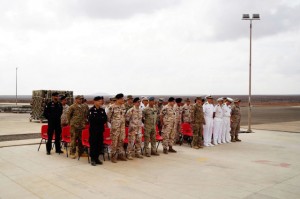2015-03-08 The Italian Air Force deploys a Remotely Piloted Aircraft Wing, namely the 32nd Wing.
The 32nd wing of the Italian Air Force, operates the remote controlled aircraft known as Predator, and completed their first tasking with the EU Naval Force in September 2014.
According to a September 2014 story:
The Italian Predator team, which is based in Djibouti, carried out a successful 11 hour check test flight and was able to highlight its effectiveness in carrying out long-range surveillance and reconnaissance patrols.
In the coming months the remote controlled aircraft will be used to monitor the seas off the coast of Somalia where pirates have been known to operate and give an early warning of a possible attack.
As is the case with EU Naval Force warships and Maritime Patrol and Reconnaissance Aircraft, the remote controlled aircraft can also be used to monitor the safety of World Food Program vessels as they transit the Indian Ocean.
More recently, the 32nd Wing deployed with Task Force Air Djibouti within the frameowrk of the EUNAVFOR mission in the Horn of Africa has concluded.

According to a story published on the Italian Ministry of Defense website on March 3, 2015:
Task Force Air deployed to Djibouti on 6 August 2014. It has operated within the framework of EUNAVFOR mission “Atalanta”, the European Union counter-piracy operation implemented in the Somali Basin and Horn of Africa to protect merchant and World Food Program ships.
Various European countries provided naval and air assets to the Operation which, over the last 6 months, was implemented by Combined Task Force 465 under Italian lead.
Italian Air Force Remotely Piloted Aircraft, provided by AF 32nd Wing, have been employed for over 300 flight hours in information collection, surveillance and reconnaissance activities within the framework of Task Force Air Djibouti. The mission’s objective was to protect Navy and merchant ships in transit in the Gulf of Aden from piracy threats.
RPAS (Remotely Piloted Aircraft) intrinsic capabilities allow conducting high-value operational missions. This time, Line-Of-Sight and Beyond Line-Of-Sight modes were used. The latter involved personnel and vehicles from Amendola Airport (Italy) via satellite connection, while the former was managed on a local basis by air crews stationed in Djibouti.

